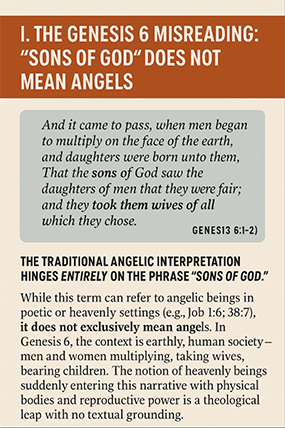I. The Genesis 6 Misreading: "Sons of God" Does Not Mean Angels
"And it came to pass, when men began to multiply on the face of the earth, and daughters were born unto them, That the sons of God saw the daughters of men that they were fair; and they took them wives of all which they chose." (Genesis 6:1-2)
The traditional angelic interpretation hinges "entirely" on the phrase "sons of God" (bene elohim), arguing that it must refer to angels. While this term can refer to angelic beings in poetic or heavenly settings (e.g., Job 1:6; 38:7), it does not exclusively mean angels. In Genesis 6, the context is earthly, human society—men and women multiplying, taking wives, bearing children. The notion of heavenly beings suddenly entering this narrative with physical bodies and reproductive power is a theological leap with no textual grounding.
The Sethite Interpretation: A More Consistent Reading
The most contextually sound interpretation identifies the "sons of God" as descendants of Seth—the godly line established after Abel's murder. Genesis 4:26 records that in Seth's time, "men began to call upon the name of the LORD," establishing a distinction between the godly line (Seth's descendants) and the ungodly line (Cain's descendants). When Genesis 6 speaks of "sons of God" taking "daughters of men," it describes the intermarriage between the godly and ungodly lines, resulting in spiritual compromise and moral corruption.
This interpretation maintains narrative consistency with the preceding chapters and requires no supernatural intervention or violation of angelic nature. The phrase "took them wives" (Gen. 6:2) implies marriage, a practice that Jesus explicitly says angels do not engage in.
Linguistic Analysis of "Bene Elohim"
While "sons of God" can refer to angels in certain contexts, the phrase is not exclusively angelic. In Deuteronomy 14:1, Israel is called "children of the LORD your God." In Hosea 1:10, believers are called "sons of the living God." The determining factor is context, not automatic angelic designation. The earthly, matrimonial context of Genesis 6 supports human rather than angelic identification.
II. Jesus' Statement on Angels and Marriage
"For in the resurrection they neither marry, nor are given in marriage, but are as the angels of God in heaven." (Matthew 22:30)
This statement is not merely about marital customs in eternity—it draws a clear comparison: angels do not marry. The grammar implies a universal truth about angelic nature. Jesus doesn't say "some" angels or "those in heaven now," but draws a moral and functional line between angels and humans: angels are outside the realm of marital and sexual union. There is no biblical evidence that angels are even curious about such customs.
Addressing the "Fallen Angels" Objection
Proponents of the Genesis 6 theory argue that Jesus spoke only of holy angels, not fallen ones. But this objection ignores the underlying reason angels don't marry: not because they're good, but because they are not made for that purpose. Their kind was created whole; they do not increase, replicate, or pass on a seed all of the reasons sexual attraction exists in humans -- to perpetuate the species. God created each angel individually as a non-replicating, sexless spiritual being (Hebrews 1:14). This is not a moral condition but a design feature.
The Parallel Passages
"And Jesus answering said unto them, The children of this world marry, and are given in marriage: But they which shall be accounted worthy to obtain that world, and the resurrection from the dead, neither marry, nor are given in marriage: Neither can they die any more: for they are equal unto the angels; and are the children of God, being the children of the resurrection." (Luke 20:34-36)
This passage connects the inability to marry with the inability to die—both are characteristics of angelic nature. Angels are immortal spirits without need or ability to procreate to continue their kind.
III. Marriage and Reproduction Are Human Institutions by Design
"The woman was made for the man... Therefore shall a man leave his father and mother, and shall cleave unto his wife: and they shall be one flesh." (Genesis 2:22-24)
The phrase "one flesh" refers not only to intimacy but to reproduction—the joining of bodies for the continuation of humanity through offspring. This divine design is built into human physiology, regulated by human DNA, and governed by the biological inheritance system God created.
The Purpose of Marriage in Scripture
The Bible presents three primary purposes for marriage:
- Companionship: "It is not good that man should be alone" (Genesis 2:18)
- Procreation: "Be fruitful and multiply" (Genesis 1:28)
- Spiritual symbolism: Marriage as a picture of Christ and the Church (Ephesians 5:32)
None of these purposes apply to angels. They are not lonely (they exist in perfect fellowship with God), they do not procreate (they are immortal), and they do not need redemption (they are either elect or fallen, with no intermediate state).
The Unique Nature of Human Sexuality
Human sexuality is intricately connected to our nature as embodied souls. The physical union reflects spiritual unity, and the potential for procreation reflects our role as image-bearers of the Creator. Angels, as pure spirits, lack this embodied nature and thus cannot participate in the physical-spiritual union that defines human sexuality.
IV. The Biological Problem: Reproduction Requires DNA
Here lies one of the most overlooked yet fatal flaws in the fallen angel theory: reproduction is a function of DNA.
- DNA is the biological blueprint for living organisms
- It determines everything from physical traits to genetic inheritance
- All sexual reproduction depends on the joining of male and female gametes, which carry DNA in sperm and eggs
So, ask the obvious question: where would angels get DNA? Are angels assigned chromosomes (23 from each parent)?
- Do they have reproductive cells?
- Are they carbon-based life forms with cellular biology?
Nothing in Scripture suggests this. In fact, Hebrews 1:7 says God "makes his angels spirits," and Hebrews 1:14 affirms they are "ministering spirits." Spirits do not bleed, reproduce, or mutate.
This makes the Genesis 6 theory not only biblically unsupported but biologically absurd.
The Complexity of Genetic Inheritance
Modern genetics reveals the staggering complexity of reproduction. Human DNA contains approximately 3 billion base pairs, and successful reproduction requires:
- Compatible genetic material from both parents
- Proper chromosomal alignment during meiosis
- Functional reproductive systems in both male and female
- Hormonal regulation of the reproductive process
- Cellular machinery for DNA replication and repair
To suggest that angels could somehow interface with this biological system without possessing it themselves is to propose a miracle for which Scripture provides no precedent or necessity.
The Species Barrier
Biology demonstrates that reproduction is generally limited to members of the same species. While some closely related species can produce offspring, like horses and donkeys producing mules, these hybrids are typically sterile (mules can produce after their kind). The supposed angel-human hybrid would represent a cross between entirely different orders of creation—spirit and flesh—with no biological basis for compatibility.
V. Appearance Is Not Embodiment
While angels may assume human appearance, this is not equivalent to full embodiment. The incarnation of Christ was unique in that God took on actual human nature AND biology —complete with blood, lineage, and mortality. Angelic manifestations, such as the angels in Genesis 18, were forms assumed temporarily, without descent, biology, or inheritance.
The Doctrine of Incarnation vs. Manifestation
Christian theology distinguishes between incarnation (becoming flesh) and manifestation (appearing in form). Christ's incarnation was:
- Permanent: He remains the God-man forever
- Complete: He assumed full human nature, including body and spirit (God)
- Functional: He could truly hunger, thirst, suffer, and die (God - as defined in James 2:26)
- Generative: He was born of a woman through normal biological processes
Angelic manifestations are:
- Temporary: Angels appear and disappear as needed
- Limited: They assume only the appearance necessary for their mission
- Non-functional: They do not possess true biological systems
- Non-generative: They cannot produce offspring
The Purpose of Angelic Manifestation
When angels appear in human form, it serves specific purposes:
- Communication: To deliver messages comprehensible to humans
- Comfort: To provide visible assurance of God's presence
- Protection: To guard or deliver God's people
- Judgment: To execute divine judgment
None of these purposes require reproductive capability. The manifestation serves the mission, not personal desire or biological function.
VI. Blood and Life: Why Jesus Had to Become a Man
Another theological refutation is the role of blood in life and salvation.
"For the life of the flesh is in the blood: and I have given it to you upon the altar to make an atonement for your souls..." (Leviticus 17:11)
Only human blood could make atonement for human sin. This is why Jesus—God manifest in flesh—was born of a woman (Galatians 4:4), took on human form, and was made "in all points like unto his brethren" (Hebrews 2:17). The incarnation wasn't just a visual appearance; it was a full assumption of humanity, including blood.
The Necessity of the Incarnation
"Forasmuch then as the children are partakers of flesh and blood, he also himself likewise took part of the same; that through death he might destroy him that had the power of death, that is, the devil" (Hebrews 2:14).
Jesus had to become truly human to:
- Represent humanity: As the second Adam
- Suffer death: To pay the penalty for sin
- Offer acceptable sacrifice: Through His human blood
- Sympathize with weakness: Having experienced human limitations
Angels cannot fulfill any of these requirements because they lack the essential human nature necessary for redemption.
The Significance of Blood in Scripture
Throughout Scripture, blood represents life and is central to atonement:
- Life principle: "The life of the flesh is in the blood" (Leviticus 17:11)
- Sacrificial system: Animal blood covered sin temporarily
- Christ's atonement: His blood provides eternal redemption
- Communion elements: Wine symbolizes His blood
Angels do not have blood. They don't die. They are spirits. Therefore, they could never have produced Nephilim, because blood is inherited—and the Bible affirms that all reproduction flows from the seed of man and the womb of woman.
XVII. Conclusion: God Made Man for Woman, Not Angels
Scripture is abundantly clear:
- Angels do not marry
- Angels do not reproduce
- Angels do not possess blood or DNA
- Sexual reproduction was designed solely for humanity
Every attempt to impose sexual function onto angels breaks biblical design, biology, and theology. The Genesis 6 angel theory collapses under scrutiny—it requires us to assume too much, violate too many clear scriptures, and invent capabilities for angels that God never gave them.
The Theological Implications
Accepting the angel theory would require us to:
- Contradict Jesus' clear teaching about angels
- Invent biological capabilities for spirits
- Compromise the doctrine of the incarnation
- Question the justice of God in the flood
- Undermine the uniqueness of human sexuality
- Rely on extra-biblical sources for doctrine
The Practical Implications
The angel theory often leads to:
- Unhealthy fascination with sensational interpretations
- Neglect of clear moral teachings in favor of speculative doctrine
- Confusion about the nature of angels and their role
- Distraction from the real message of Genesis 6 about human sin and divine judgment
The Simple Truth
God made the woman for the man—not for angels. Jesus came in the likeness of sinful flesh; a man to have blood. And only in human blood is there life for the redemption of souls.
The sons of God in Genesis 6 were not angels. They were men—possibly of the line of Seth—who abandoned righteousness, took women in lust, and birthed a violent, corrupt generation. The flood came because of human sin—not celestial genetics.
Let God's Word speak plainly. Angels do not breed. They serve.
Let no myth, no apocryphal tale, and no corrupted tradition teach otherwise. The clarity of Scripture, the consistency of theology, and the reality of biology all unite in refuting the ancient error that angels can marry, reproduce, or bleed.
In an age of theological confusion and biblical illiteracy, we must return to the simple, clear teaching of Scripture. The angel theory may capture the imagination, but it cannot capture the truth. God's Word stands forever, and it speaks with one voice: angels are spirits, humans are flesh, and never the twain shall meet in marriage bed or birthing chamber.
The question is not whether angels could have done this, but whether Scripture teaches that they did. And on that question, the Word of God speaks clearly: they did not, they could not, and they will not.
Thus stands the case against the Genesis 6 angel theory—refuted by Scripture, contradicted by biology, and abandoned by sound theology. Let the church return to the clear teaching of God's Word and abandon the fables that have long clouded this passage.
The truth is simple: God made man for woman, angels for service, and Scripture for our understanding. When we honor these boundaries, we honor God. When we cross them, we follow the path of confusion that began in the garden and continues to this day.
May God grant us wisdom to discern truth from error, Scripture from speculation, and divine revelation from human imagination. In this, as in all things, let God be true and every man a liar who would contradict His clear Word.


